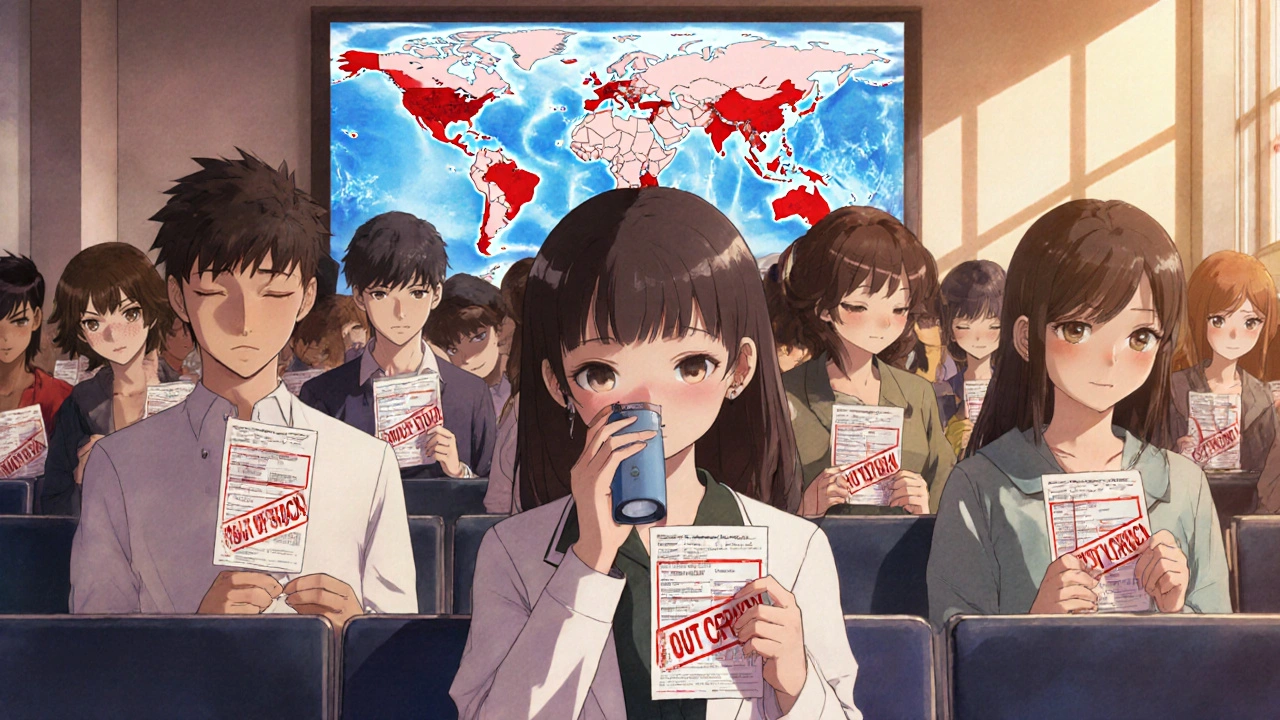Pricing Pressure and Shortages: How Supply Chains Are Reshaping Health Costs
 Nov, 19 2025
Nov, 19 2025
When medicines disappear and prices spike
It started with insulin. Then it was antibiotics. Then IV fluids. By early 2022, hospital pharmacies across the U.S. and Europe were calling suppliers daily, not to order more, but to beg for anything they could get. The same thing happened with asthma inhalers, cancer drugs, and even basic painkillers. People weren’t just paying more-they were going without. This wasn’t a temporary glitch. It was a systemic breakdown.
What happened? Pricing pressure and shortages hit health care like a double wave. Supply chains snapped under the weight of pandemic demand, labor shortages, and geopolitical shocks. At the same time, demand for health goods didn’t drop-it surged. The result? Prices climbed faster than wages, and shelves went bare.
Why shortages hit health care harder than other industries
Not all shortages are the same. When a smartphone runs out, you wait a few weeks. When a life-saving drug runs out, people die. Health care doesn’t have substitutes. You can’t swap one antibiotic for another if your infection is resistant. You can’t use a different IV fluid if your patient is in shock.
Supply chains for medicines are incredibly narrow. Most generic drugs are made in just one or two factories-often in India or China. When a factory shuts down for inspections, a storm knocks out power, or a trade ban kicks in, the whole world feels it. In 2021, a single plant in India had to pause production of injectable antibiotics after a fire. Within months, U.S. hospitals reported 40% fewer supplies of those drugs.
And it’s not just manufacturing. Raw materials matter too. The active ingredients in many medicines come from a handful of chemical suppliers. When energy prices spiked in 2021, those suppliers cut back. No electricity? No synthesis. No synthesis? No pills. The Office for Budget Responsibility found that UK pharmaceutical input costs rose 25-40% in late 2021-directly because of energy and logistics bottlenecks.
How pricing pressure turns into panic buying
When a drug becomes scarce, prices don’t just rise-they explode. But here’s the twist: it’s not always the manufacturer raising prices. Often, it’s the system itself.
Imagine you’re a pharmacy. You used to get 1,000 units of a drug each month. Now you get 300. The supplier says, ‘Take it or leave it-and it’s 200% more.’ You don’t want to run out. So you buy what you can. Other pharmacies do the same. Demand spikes artificially. The price keeps climbing. Soon, patients are paying three times more. And the drug still isn’t on the shelf.
This is called speculative hoarding. Harvard economist Martin Weitzman showed this pattern decades ago: when people expect a shortage, they buy more than they need. That makes the shortage worse. In 2022, the University of Michigan’s consumer surveys found 58% of households worried about not being able to buy the medicines they needed. That fear drove real behavior-people stockpiled prescriptions, emptied pharmacy shelves, and sometimes skipped doses to make supplies last.
Even price controls backfired. In the UK, the government capped how much energy companies could charge. That saved households-but it broke small energy providers. Between August and December 2021, 27 of them collapsed. The same thing happened with health suppliers: if regulators cap prices too tightly, manufacturers stop making the product. No profit? No production.

The labor shortage behind the medicine gap
It’s not just factories. It’s people.
By mid-2022, the U.S. had 1.5 million fewer workers in health care than before the pandemic. Nurses, pharmacists, lab technicians-all in short supply. And it wasn’t just burnout. Many skilled workers left the field entirely. Others couldn’t get licensed fast enough. In some states, it took 9 months to renew a pharmacy license. That’s 9 months without someone to fill prescriptions.
The Federal Reserve found that labor shortages in health care contributed to a 0.15% drop in employment across related sectors. That might sound small, but in real terms, it meant fewer people available to manufacture, transport, or dispense medicines. One hospital in Ohio reported a 30% increase in delayed treatments in 2022-not because of lack of beds, but because no pharmacist was available to prepare the drugs.
And it’s not just frontline workers. The people who pack and ship medicines? Also in short supply. Trucking companies couldn’t find drivers. Ports were backed up. The San Francisco Federal Reserve’s Global Supply Chain Pressure Index hit a record 3.88 in December 2021-nearly 25 times higher than pre-pandemic levels. Every delay meant drugs sat on ships instead of in hospitals.
Who pays the price? Patients, providers, and the system
The economic toll is layered.
Patients pay more out of pocket. A 2023 study in The New England Journal of Medicine found that patients on fixed incomes skipped doses of diabetes and heart medications because of cost. One in five reported going without a prescribed drug in the past year.
Hospitals pay more too. In 2022, U.S. hospitals spent 18% more on pharmaceuticals than in 2019. Some spent 50% more on just three critical drugs. That money had to come from somewhere. So hospitals cut back on staff, delayed equipment upgrades, or raised fees for other services.
And insurers? They raised premiums. The International Monetary Fund estimated that supply chain disruptions added 1.5 percentage points to global health inflation between 2021 and 2023. In emerging markets, the impact was even worse-25-30% higher than in rich countries. Why? Because they rely more on imported medicines and have fewer backup suppliers.

What’s being done-and what’s working
Change is happening, but slowly.
Some companies are shifting away from single-source suppliers. A 2022 McKinsey survey of 500 global firms found that companies using two or more suppliers for critical drugs recovered from shortages 35% faster. One U.S. cancer center started sourcing chemotherapy drugs from three different countries. When one supplier failed, they switched. No disruption.
Digital tools are helping too. Hospitals using AI-powered inventory systems reduced stockouts by 28%. Instead of guessing how much insulin to order, they now predict demand based on patient volume, seasonality, and delivery delays.
Some governments are acting. Germany relaxed competition rules temporarily in 2021 so pharmacies could share scarce drugs. The result? Pharmaceutical shortages dropped by 19% in six weeks. The U.S. passed the Pharmaceutical Supply Chain Security Act in 2023, requiring better tracking of drug origins. The EU launched a €1.8 trillion support fund for energy-intensive drugmakers.
But the biggest fix? Flexibility. The Office for Budget Responsibility warned that rigid labor rules and fixed production lines make shortages worse. Countries that allowed faster licensing, temporary visas for skilled workers, and flexible manufacturing saw quicker recoveries.
What’s next? The next wave is already here
Supply chain pressure dropped back to near-normal levels by early 2023. That’s good news. But don’t celebrate yet.
The International Monetary Fund says supply chain disruptions will stay 15-20% above pre-pandemic levels through 2025. Why? Climate events. Geopolitical tension. More factories closing in China. More energy volatility. More labor shortages.
And now, the focus is shifting to services. While goods shortages are easing, hospitals are now facing staff shortages that can’t be fixed by shipping more pills. Waiting rooms are full. Nurses are exhausted. The next crisis won’t be empty shelves-it’ll be empty beds.
Companies are preparing. Gartner predicts that by 2025, 60% of major health firms will use digital twins-virtual models of their supply chains-to simulate disruptions before they happen. That’s smart. But it’s expensive. Will small clinics afford it?
What you can do now
- Don’t stockpile. Hoarding makes shortages worse. Only take what you need for the next 30 days.
- Ask about alternatives. If your drug is unavailable, ask your doctor if a generic or similar drug works. Many are just as effective.
- Support local pharmacies. Big chains have more leverage. Local ones often get left out. If your pharmacy is struggling, buy from them-even if it’s a little more expensive.
- Advocate for transparency. Demand to know where your medicines come from. Pressure lawmakers to support diversified supply chains.
The era of cheap, abundant medicines is over. But it doesn’t have to be a crisis. With smarter systems, better policies, and more resilient networks, we can build a system that doesn’t break when the next shock hits.

Dion Hetemi
November 20, 2025 AT 00:25Brian Rono
November 21, 2025 AT 10:20Andy Feltus
November 22, 2025 AT 02:10Zac Gray
November 22, 2025 AT 08:59Dana Dolan
November 23, 2025 AT 00:11Kara Binning
November 24, 2025 AT 00:58river weiss
November 25, 2025 AT 08:45Steve and Charlie Maidment
November 25, 2025 AT 10:30seamus moginie
November 25, 2025 AT 15:08